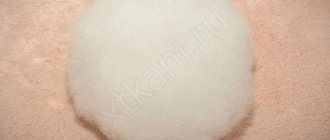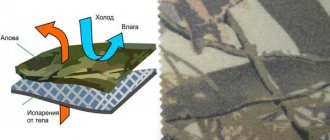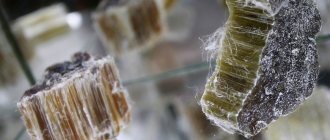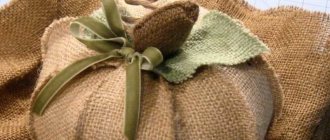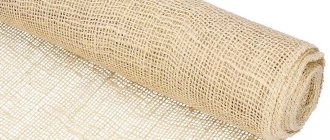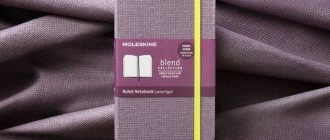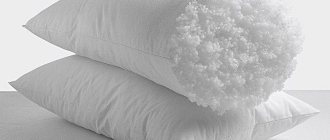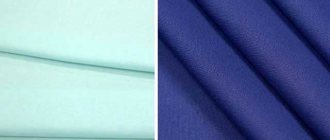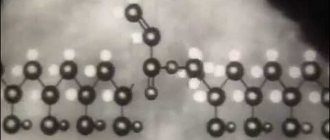Home / Fillers
Back
Published: 06/23/2021
Reading time: 3 min
0
8
Synthetic insulation is confidently replacing natural materials, becoming more perfect each time. Synthetic fluff, popular today, is insulation that is as similar as possible to natural material. Outwardly, it is almost indistinguishable from swan down, it warms well, and lasts a long time. What are its features, advantages, disadvantages - everything in order.
- 1 Composition and appearance of the material
- 2 Characteristics 2.1 Advantages
- 2.2 Disadvantages
Features and characteristics of synthetic fluff filler
Synthetic down is almost identical to natural down. Increased thermal insulation properties are achieved due to the presence of air in the fibers.
The fabric holds its shape well and recovers quickly.
Composition: what is the material made from?
The material is a non-woven insulation made on the basis of polyester. It consists of fibers with a hollow space inside, due to this the lightness of synthetic fluff is achieved. The size of the cavities is so small that moisture does not penetrate inside them. Electricity does not accumulate in the fabric, things are put on and taken off without difficulty or electrostatic sounds. Find out about curtains on one side for a bedroom window here.
What properties does it have?
Synthetic fluff retains heat and does not allow moisture to pass through. Clothes remain dry even after being exposed to rain or snow. Even a thoroughly wet down jacket retains its thermal insulation properties and it is impossible to freeze in it. The material retains its shape well and dries quickly. When washed in a washing machine, the filling does not roll up, things do not shrink, they retain their volume, there are no lumps or hollow areas.
Up to how many degrees is the insulation, at what temperature
A synthetic down jacket retains heat at -30 degrees and wind speed of 15 m/s.
You can wear such clothes in any cold weather, the region of residence does not matter.
Advantages and disadvantages
The main advantages of synthetic down:
- hypoallergenic, lack of skin irritation and other reactions to the material;
- resistance to the accumulation of dirt, dust, microorganisms;
- breathability - oxygen reaches the skin, which avoids sweating;
- moisture resistance - achieved through external treatment with silicone;
- antistatic properties;
- odor resistance;
- ease of care - you can wash things in a washing machine;
- long-term operation - reaches several decades;
- resistance to mold, fungi;
- hypoallergenic.
When developing the material, the characteristics of the skin were taken into account. Things made from synthetic fluff are safe for children; no glue, synthetic dyes, fragrances, formaldehydes, or other toxic components are used in their production.
The main disadvantage of synthetic down, batting and teak material is considered to be quite high cost. Regular washing can cause premature wear of the material.
Production: how to get it
Waste PET containers, ready-made flex flakes, and granulated recycled PET are used as raw materials for the production of synthetic fluff. Ready-made flex flakes are considered the best option, since the raw materials have not been melted. Polyester thread is obtained from raw materials using an extruder, where it is melted, mixed, and averaged. The raw material passes through a melt filter, a pump, and a spinneret, from where the finished thread enters the winding station. At the last stage, the synthetic fluff is treated with a layer of silicone, due to this it becomes moisture-resistant and resistant to gluing. Read how to choose a baptismal set for a girl here.
The fibers obtained in this way are formed into bales. The spools are threaded into a special stand, where the threads are tangled and coated with silicone. The tangled fabric is torn into pieces. At the next stage, the fiber enters carding machines, where voids are created in it using needles. The material acquires the properties of a spring, increasing its elasticity and resistance to stress. Synthetic fluff is packaged in briquettes or bags. Agatsib Novosibirsk will tell you about knitwear in this material.
Areas of use
The main advantage of the insulation is the unique structure of the fibers and the material itself, which is characterized by the presence of air cells on the surface of the villi. This structure ensures maximum heat conservation. Things made from synthetic bio-down are designed for extreme temperatures. They are comfortable even in severe frosts - down to -30 °C. In addition, the air gap protects against wind gusts of up to 15 m/s.
The main area of use of synthetic down is sewing winter and insulated demi-season clothing for children and adults.
Other applications:
- sports and travel equipment;
- mattresses, sleeping bags;
- pillows, blankets;
- soft toys, furniture;
- interior accessories.
Varieties
Based on linear density, the following types of synthetic fluff are distinguished:
- fiber length (32 or 64 mm);
- thickness (7 D or 15 D).
Varieties of hardness:
- Soft (7D/32) - is versatile, soft, and retains its shape.
- Hard (15D/64) – characterized by increased elasticity, quickly recovers after load, not intended for stuffing small products.
- Cotton wool - resembles cotton in appearance, is lightweight, has low density, fluffy structure, and low strength.
- Balls - made in soft and hard forms, the balls are formed due to dense twisting during carding, due to this elasticity and excellent shape retention are achieved.
How to choose a down pillow
It’s impossible to make the right down pillow in artisanal conditions. After all, the raw materials for filling must be cleaned. Typically, four to fifteen stages will be needed. After this, the material is dedusted. Then they are treated with steam and dried. This will require professional expensive devices. A down pillow made of quality material cannot be cheap.
A small number of small feathers are allowed during production. The type of filler depends on their content. Real down products include a pillow in which the ratio of down to feathers is 85/15 or higher. One hundred percent pure down can only be achieved through manual processing. This technology is very expensive. Therefore, the price of the pillow will be appropriate.
When purchasing, be sure to pay attention to several nuances:
- If you crumple a pillow, a quality product will instantly restore its shape.
- The down pillow should not rustle, rustle, squeak or make any sounds.
- A pillow with high-quality filling cannot have any foreign odors.
- If one of the points is violated, the production technology was not followed or low-quality material was used. It is not recommended to buy such a product.
- On the label, the manufacturer is required to indicate several details: the material used, size chart, degree of elasticity, diaper, care tips, manufacturing technology.
The cover also plays an important role. Manufacturers often use cotton cambric, cotton, sateen, cambric, jacquard cambric, silk muslin, silk, and teak as a bedding.
Products with teak covers are especially popular. It is usually made from 100% cotton. It is distinguished by wax impregnation and dense weave of threads (about 145 grams/sq. m.). Thanks to the production technology, down and feathers are not allowed to move through the pillowcase.
In specialized bedding stores, it is recommended to buy products from Austrian and German manufacturers. They also add seaweed, silver ions, vitamins, aromatic oils and extracts to the fabric. Several Chinese companies use synthetic fibers or low-quality impregnation in their production. The fabric may become rough. A characteristic rustling sound will appear.
You can find out detailed information about the dangers of down pillows from the story:
Scope of application: what to sew
Synthetic down fillings are widely used in the manufacture of upholstered furniture, armchairs, and children's goods (toys, playpens).
Synthetic down is indispensable when creating goods for sports and tourism - equipment, backpacks, sleeping bags, tents.
Winter clothes: jackets and down jackets
The material is used in the manufacture of down jackets, outerwear, coats, and warm trousers. The thermal insulation properties of goods depend on the filling density. Read about Belarusian plus size clothing in this article.
For pillows
Synthetic fluff is used for filling regular sleeping and decorative pillows, as well as for blankets.
Similarities
Both materials have similar qualities, so a pillow with such synthetic fillings has similar characteristics. Despite the manufacturing technology, synthetic fluff and holofiber are absolutely environmentally friendly. They are distinguished by their hypoallergenic qualities; dust mites and other microorganisms do not develop inside.
The materials do not allow air to pass through very well, which does not allow excess moisture to evaporate. Due to this characteristic, pillows are difficult to use in summer. The compression field quickly restores its original shape.
Recommendations for product care
Ease of care is considered one of the important advantages of synthetic down. It is not necessary to take the item to the dry cleaner; everything can be done at home. A jacket, blanket or pillow can be washed in a washing machine; you should first read the manufacturer’s recommendations.
The filler will retain its properties even after machine and hand washing.
How to wash in a washing machine
When washing items in automatic mode, the choice of mode plays an important role. The best option is a delicate washing cycle at a temperature of 40-60 degrees. Theoretically, it is possible to wash the material at higher temperatures; this should be done only in cases of extreme necessity, in the presence of heavy soiling. The delicate mode will help preserve the performance properties of the fabric longer. Find out about the knitwear catalog from Beloshveyka Raskazovo at this link.
When carrying out the procedure, certain rules must be followed. Synthetic down filling is most often used in the manufacture of bulky items, so it is recommended to wash them separately.
Before placing an item in the washing machine, you should make sure that the lining and outer fabric are intact. If there is even minor damage, the water temperature should not exceed 40 degrees; failure to comply with this condition will lead to an increase in the area of damage. Spinning at low speeds will help preserve the texture and shape of the filler.
Before washing, it is recommended to apply the cleaning agent to all areas exposed to contamination (bottom, cuffs, collar, sleeves). This approach will improve washing efficiency. At the final stage, it is recommended to rinse the item in running water, this will get rid of stains and streaks.
Synthetic fluff can be washed even at 90 degrees. The delicate mode will help avoid deformation of the item. If necessary, clothes can be ironed at a temperature not exceeding 100 degrees.
Pillows for garden swings, like regular ones, are recommended to be washed only by hand, as there is a risk of fiber clumping. Add detergent to water not hotter than 40 degrees and place the pillow in soapy water for 30 minutes. Exposed stains and dirt must be carefully removed with a brush. Rinse the product several times, wring it out lightly, avoiding twisting. Rinse the pillow until the water runs clear. It is recommended to dry a baby pillow for a child on a horizontal surface, the place should be well ventilated. It is recommended to shake the product periodically.
The blanket is quilted with stitches, so the possibility of lumps is eliminated. When washing in a washing machine, for such items as duplerin and double-thread footer, you should set it to the delicate cycle. It is important that the product fits completely into the drum. Additionally, it is recommended to place 2-3 tennis balls in the machine, which will beat the filler.
Pillows filled with down and feathers
Previously, feather pillows simply had no competitors. Everyone, regardless of income and social status, slept on the same pillows - down and feathers. True, those who lived in the village and had the opportunity to pluck chickens and geese in large quantities could only afford down pillows, without any feathers, however, these could still be bought for a fairly decent amount.
“Testing” down and feather pillows for many years, I studied all their advantages and disadvantages.
Advantages
— Natural filler, provides a pleasant tactile sensation.
- Durable. Previously, they were inherited not only by daughters, but also by granddaughters?? With proper care, it can easily serve you for five, six (ten...)))
- Warm, soft and fluffy.
- Highly breathable
Flaws
- Allergenic. Moreover, the allergen is not the fluff itself, but microscopic mites that love to live in it.
According to the manufacturers, even if you are allergic, among modern down and feather pillows you can find an option for yourself - the pillows are filled with disinfected down, to which is added a cover made of a special fabric through which not only the filler, but also the mites living in it cannot penetrate.
— It’s almost impossible to wash it yourself, so you need to periodically take it to the dry cleaner, and you’ll have to do this quite often (most recommendations come down to the figure - once every six months). Once upon a time I tried to wash a pen myself, it was terrible...))
- If you sweat a lot in your sleep, the feather begins to acquire an unpleasant odor.
- If you put a not very high-quality pillowcase on your pillow, you will constantly see downy fluff flying around the apartment, and the prickly tips of feathers will peek through the fabric.
— For me personally, the disadvantage is that the pillow is not entirely “anatomical”; if there is a lot of down and feathers in it, it becomes springy and too elastic; if you remove some of the filler, by the morning it “crawls” out from under your head, settling in the corners .
Since for me the shortcomings of these pillows clearly prevail, I would not buy them again, perhaps making an exception only for pillows from modern companies that produce their products in accordance with new technologies, with varying degrees of support and filler processing.
These pillows have only one minus - the price. Its cost is about $120...
Price of a regular down and feather pillow: about $14.
My subjective rating: 4/4.
Alternative
Different materials are used as filler; they all have similar properties, but they also have differences.
The most famous analogues of synthetic down are considered to be holofiber, isosoft, and thinsulate.
What is warmer: synthetic fluff or down?
Natural down is considered the lightest filler; it provides reliable protection from the cold. Down jackets filled with loon and goose down are considered the warmest; they are suitable for residents of cold regions who are forced to go outside in frosty weather - 30 degrees and colder. For warmer regions, down jackets with synthetic down are suitable.
When washed in a washing machine, feathers come out, which creates problems when wearing and caring. Products made from synthetic fluff always maintain their integrity.
Which is better: synthetic fluff or Thinsulate?
Thinsulate is an innovative material, also called swan down. The material was originally created by order of NASA for astronauts. Its main feature is the ideal combination of weight and volume. According to manufacturers, the thermal insulation properties of Thinsulate are one and a half times higher than those of natural down, so it is warmer than synthetic down. The fiber is sixty times thinner than a hair.
Thin filler retains heat well; its thickness is often several times less than the thickness of synthetic down and other analogues.
When washing, the filler does not clump together. It can be washed at home, the material is resistant to deformation and dries quickly.
Unlike synthetic down, Thinsulate accumulates electricity, which can create problems when taking it off and putting it on. The disadvantages also include the high cost of the material.
Holofiber filler
This type of material is also of synthetic origin. For production, polyester raw materials are used, which are heat-sealed. Holofiber does not contain harmful substances that can harm human health. According to these indicators, it approaches natural substances.
To make a high-quality pillow, holofiber in the form of balls is used. They have good elasticity. The material has excellent heat-saving qualities, so it is used not only to create bedding, but is also used as insulation for clothes and blankets.
